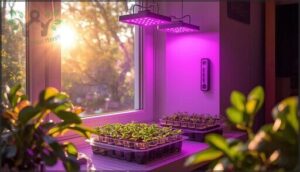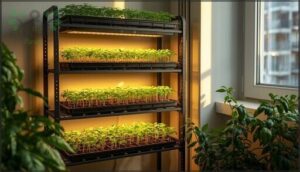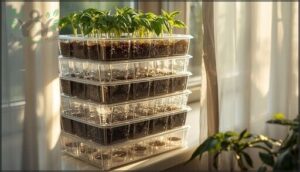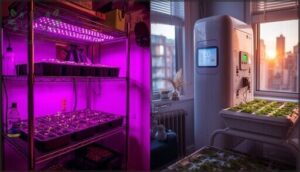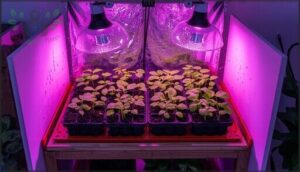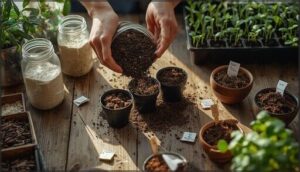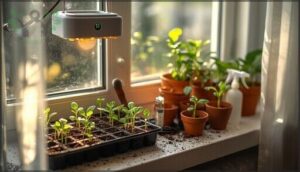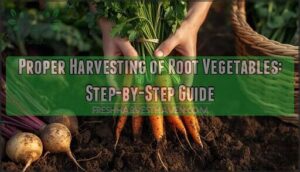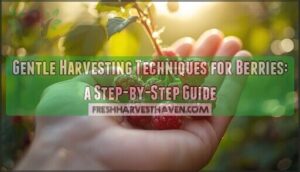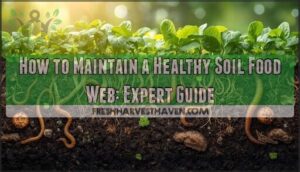This site is supported by our readers. We may earn a commission, at no cost to you, if you purchase through links.
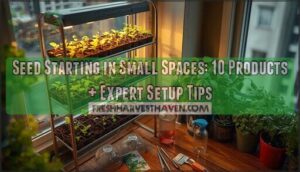
The secret lies in working vertically instead of horizontally, choosing containers that eliminate wasted space, and selecting compact varieties that deliver impressive harvests without demanding square footage you don’t have.
With stackable trays, biodegradable pots, and a few smart products, you can start dozens of seedlings in the footprint of a single chair. This guide covers the essential methods, products, and expert strategies that turn tight quarters into thriving gardens.
Table Of Contents
- Key Takeaways
- Seed Starting Basics for Small Spaces
- Maximizing Indoor Seed Starting Setups
- Choosing The Best Seed Starting Mix
- Top 10 Seed Starting Products for Small Spaces
- 1. Back to Roots Seed Starting Pots
- 2. RooTrimmer 5 Tier Seed Stand
- 3. NEWKITS Seed Starter Tray Grow Light
- 4. Set of 43 Heirloom Garden Seeds
- 5. BlumWay 2 Inch Soil Blocker
- 6. PVP Medium Vermiculite Soil Conditioner
- 7. Burpee 72 Cell Seed Starter
- 8. Root Radish Red Organic Bunch
- 9. Hydroponic Seed Starter Tray Kit
- 10. Scott ComfortPlus Toilet Paper Double Rolls
- Expert Tips for Successful Small-Space Gardening
- Frequently Asked Questions (FAQs)
- Conclusion
Key Takeaways
- Vertical growing systems like stackable trays and tiered racks can triple or quadruple your seedling capacity without claiming additional floor space, making them essential for apartment and small-space gardeners.
- Biodegradable containers and soil blocking methods eliminate transplant shock and plastic waste while promoting stronger root development, with some systems saving up to 100 disposable pots per season.
- Self-watering systems and consistent LED lighting (14-16 hours daily, positioned 2-4 inches above seedlings) dramatically reduce maintenance demands and boost germination rates to 85-98% in compact setups.
- Choosing compact plant varieties like dwarf tomatoes, patio cucumbers, and bush beans paired with proper seed starting mix (light, well-draining, never garden soil) ensures high yields even in containers measuring just a few square feet.
Seed Starting Basics for Small Spaces
Starting seeds in a small space doesn’t mean you have to sacrifice variety or yield. The key is choosing the right methods and containers that work with your square footage, not against it.
Let’s look at four foundational approaches that’ll help you grow strong seedlings without taking over your entire apartment.
Essential Seed Starting Methods for Limited Areas
When you’re short on square footage, the right seed starting method can turn a cramped corner into a thriving nursery for your future garden.
Three space-saving methods deliver impressive results in compact areas:
- Biodegradable peat pots reduce transplant shock while promoting healthy root development through natural air circulation.
- Soil block benefits include eliminating containers entirely, creating compressed blocks that strengthen roots and minimize waste.
- Vertical seed starting racks amplify space efficiency by stacking trays upward instead of outward.
Choosing Compact and High-yield Plant Varieties
Your available space dictates which plants will actually thrive, not just survive. Compact plant varieties—like dwarf tomatoes, patio cucumbers, and bush beans—deliver impressive yields without sprawling across your balcony. Container vegetables such as lettuce and peppers fit perfectly in small spaces, while herbs like basil and thyme get the most out of space efficiency on windowsills.
Patio fruits including strawberries work beautifully in hanging baskets, and vertical growing methods let climbing varieties like pole beans stretch upward instead of outward. Some compact varieties, like peppers, can even be grown in smaller sized pots.
Benefits of Biodegradable and Eco-friendly Containers
Once you’ve picked the right plants for your space, the containers you choose can make your small-space garden even greener. Biodegradable peat pots break down naturally in soil, which means you reduce waste while supporting healthy plant growth. These eco-friendly gardening options allow roots to breathe better and eliminate transplant shock since you plant the entire pot directly into the ground.
Soil blocking systems take this further by removing containers altogether, creating compressed blocks that promote stronger roots in small spaces while delivering real cost savings over time.
Preventing Transplant Shock in Small-space Gardens
Moving seedlings without damaging their roots can feel like threading a needle, but the right methods protect your plants from the stress that stunts growth. Transplant shock prevention starts with minimizing root disturbance and building stronger root systems before moving day arrives.
- Use biodegradable pots that break down naturally, eliminating root disturbance during transplanting
- Harden off seedlings gradually over 7-10 days to adjust temperature control and light exposure
- Water thoroughly before transplanting to keep soil composition intact around delicate root development
- Transplant during cooler hours to reduce stress and boost seedling survival rates
Maximizing Indoor Seed Starting Setups
Getting your indoor seed starting setup right can make or break your small-space garden. You’ll want to think about where you’re placing your seedlings, how you’re getting them enough light, and what kind of system fits your space and budget.
Let’s walk through the key decisions that’ll help you grow strong, healthy seedlings without taking over your entire home.
Selecting The Best Location and Light Sources
Your seedlings won’t stand a chance without the right light, and picking the perfect spot is half the battle won before you even plant a single seed. A south-facing window offers natural light for seed starting in small spaces, but you’ll likely need supplemental lighting like LED grow lights to maintain proper light duration and spectrum.
Consider location factors such as temperature stability and light exposure for seedlings, ensuring your growing conditions support strong, healthy starts.
Using Vertical Racks and Stackable Trays
When you’re working with just a few square feet, going vertical is the major advantage that lets you triple or even quadruple your growing space without claiming another inch of floor real estate.
Vertical seed starting racks offer serious space optimization tips for tight quarters:
- Adjustable shelves accommodate different seedling heights as plants grow
- Built-in LED grow lights make sure each tier receives adequate light
- Stackable trays amplify vertical space while keeping seedlings organized
- Corner placement transforms unused areas into productive growing zones
These space-efficient setups fit perfectly beside windows or against walls, making small spaces work overtime for your seed starting needs.
Optimizing Space With Self-watering Systems
Self-watering trays bring a set-it-and-forget-it convenience to seed starting that’s especially valuable when floor space is tight and you’re juggling multiple tiers of seedlings.
These space-efficient systems use capillary action to draw moisture from a water reservoir below, maintaining consistent moisture without daily attention.
Stackable trays work perfectly in small spaces, and they’re ideal for compact varieties like tomatoes and peppers that need reliable hydration during those critical early weeks.
Budget-friendly Vs. High-end Indoor Setups
Budget-friendly DIY racks with LED grow lights start under $250 and deliver germination rates between 85% and 95%, while high-end hydroponic systems reach 98%–100% germination but cost $400 to over $1,200. Both setups work brilliantly in compact spaces—budget seed starters accommodate 960 seedlings in 18 square feet, and premium systems grow faster with automated control.
Your choice depends on whether you prefer hands-on monitoring or paying more for convenience and speed. For a smaller investment, consider an Aerogarden Harvest system to start with hydroponics.
Enhancing Growth With Heat Mats and Reflective Surfaces
Heat mats can boost germination rates by 50% or more, turning sluggish seeds into sprouting seeds in half the time. Reflective surfaces like aluminum foil or white boards amplify your LED grow lights’ reach, creating ideal growing conditions without extra energy consumption.
Three heat mat benefits for small spaces:
- Faster germination – Warm soil triggers seeds 5–10 days earlier
- Stronger seedling growth – Consistent bottom heat promotes healthy root systems
- Space efficiency – Stack trays vertically while maintaining ideal temperatures
Choosing The Best Seed Starting Mix
The right seed starting mix can make or break your small-space garden before you even plant a seed. You’ll need to understand the difference between potting mix and garden soil, plus know which amendments help seeds thrive in tight quarters.
Let’s look at what makes a quality seed starting mix and how to get it right for different containers.
Importance of Potting Mix Versus Garden Soil
You wouldn’t plant a tree in concrete and expect it to thrive, so why would you fill your containers with heavy garden soil? Garden soil compacts in pots, creating drainage issues that suffocate roots and stall seedling growth.
Heavy garden soil compacts in containers, suffocating roots and stalling growth—use lightweight potting mix instead
A quality seed starting mix stays light and fluffy, promoting root development and nutrient availability.
For successful seed germination and container gardening, your growing medium makes all the difference.
Role of Vermiculite and Soil Conditioners
Think of vermiculite as the secret ingredient that transforms a basic seed starting mix into a moisture-managing powerhouse. This lightweight mineral improves soil aeration while locking in just enough water to keep seedlings hydrated without drowning them.
When you’re working with limited space, vermiculite boosts nutrient availability and creates the perfect growing medium for healthy root development in containers and trays.
Mixing for Soil Blocks and Peat Pots
Getting your soil mix right is like following a recipe — the right proportions make all the difference when filling peat pots or forming sturdy soil blocks. For soil blocks, you’ll need a blend with enough binder to hold its shape, while peat pots work best with lighter, moisture-retaining mixes.
- Soil blocks: Use 3 parts peat moss, 2 parts compost, 1 part vermiculite, plus clay or colloidal phosphate for stability
- Peat pots: Mix equal parts peat moss, vermiculite, and compost for best moisture retention
- Sterilization: Bake homemade mixes at 180°F for 30 minutes to eliminate pathogens
- Nutrient amendments: Add worm castings or kelp meal to boost seedling vigor
Ensuring Drainage and Root Health in Containers
Once you’ve nailed your mix, the next step is making sure excess water has somewhere to go — because waterlogged roots spell trouble fast, no matter how perfect your soil recipe is. Check that your containers have proper drainage holes, and include a layer of perlite at the bottom to boost aeration.
Good drainage prevents root rot and fosters strong root development, keeping root systems healthy and avoiding rootbound problems down the line.
Top 10 Seed Starting Products for Small Spaces
Finding the right seed starting products can make all the difference when you’re working with limited space. The products below help you stretch every inch, from stackable trays to vertical racks that let you grow more without taking over your home.
Each option speaks to a specific challenge small-space gardeners face, so you can build a setup that works for your situation.
1. Back to Roots Seed Starting Pots
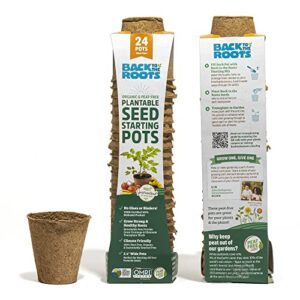
Back to Roots Seed Starting Pots offer a practical solution for anyone trying to grow plants without wasting plastic or space. These 2.4-inch biodegradable containers are USDA Certified 100% Biobased and completely peat-free, which helps protect carbon-storing peat bogs while giving your seedlings room to breathe.
The pots break down naturally after transplanting, allowing roots to grow right through the sides and minimizing transplant shock. They’re lightweight and stackable, making them perfect for small spaces like apartments or patios.
Just keep in mind that these seed starters dry out faster than plastic alternatives, so you’ll need to stay on top of watering needs to keep your herbs, vegetables, or flowers thriving.
Best For: Eco-conscious gardeners who want a simple, sustainable way to start seeds indoors without dealing with plastic waste or transplant shock.
- Fully plantable and compostable, so you can transplant seedlings without disturbing roots or creating plastic waste
- Breathable design with excellent drainage helps prevent overwatering and promotes healthy root development
- USDA Certified 100% Biobased and peat-free, protecting carbon-storing peat bogs while using renewable materials
- Dry out faster than plastic pots, requiring more frequent watering and closer attention
- Single-use only and can’t be reused, which increases costs if you’re starting large numbers of seeds each season
- May become fragile or turn to pulp with heavy watering, and decomposition rates can be inconsistent during transplant
2. RooTrimmer 5 Tier Seed Stand
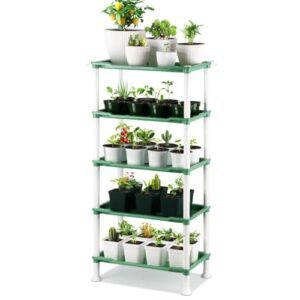
When floor space is at a premium, the RooTrimmer 5 Tier Seed Stand transforms your limited area into a productive growing zone by stacking five standard 1020 trays in a compact 34.65-inch tall footprint.
This vertical seed starting rack uses high-strength plastic shelves and stainless steel tubes with anti-corrosion coating, ensuring material durability even in humid indoor environments or outdoor setups.
The design accommodates LED grow lights for light optimization across all tiers, while removable bottom trays address water management by catching runoff.
Assembly usability is straightforward with tool-free installation taking about 20 minutes, and the detachable shelves make cleaning simple between seed starting cycles in small spaces.
Best For: Gardeners with limited floor space who need to start multiple seed trays indoors year-round while maintaining consistent light and water management across all growing levels.
- Stacks five standard 1020 trays vertically in a 34.65-inch footprint, increasing plant density by up to 300% compared to single-level setups
- Stainless steel frame with anti-corrosion coating and high-strength plastic shelves withstand humid conditions and frequent watering for extended durability
- Tool-free assembly takes about 20 minutes with detachable shelves for easy cleaning, plus optional LED grow lights boost germination rates by approximately 23%
- Some users report shelves arriving damaged or broken during shipping
- Product may appear smaller in person than expected from promotional images, with potential stability issues requiring additional support
- Lower-than-expected build quality at the budget price point may affect long-term reliability for heavy or frequent use
3. NEWKITS Seed Starter Tray Grow Light
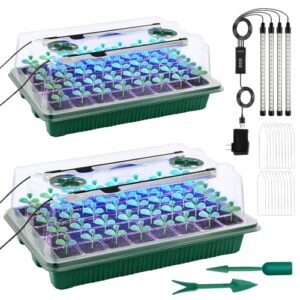
For all-in-one convenience, the NEWKITS Seed Starter Tray Grow Light bundles five 12-cell seed starting trays with integrated LED grow light systems, totaling 60 cells in a kit that fits on windowsills or shelves.
Each humidity-control dome includes four LED lights positioned two inches above the cells, delivering 1200 lux for 12–16 hours daily. The compact growing systems stack vertically, and watertight bases enable bottom watering to prevent fungal issues.
Users report germination rates above 85%, with tomatoes and peppers reaching transplant size in four to six weeks. At roughly $4 per tray with lights included, tray durability spans multiple seasons, making these hydroponic seed starter systems budget-friendly for beginners.
Best For: Beginners and small-space gardeners who want an affordable, all-in-one seed starting solution with built-in lighting and humidity control.
- Complete kit includes 60 cells, LED grow lights, humidity domes, and tools for under $20—eliminating the need for separate purchases
- Compact design fits on windowsills or shelves, with stackable trays that maximize space in apartments or small homes
- High germination rates above 85% with seedlings reaching transplant size in 4–6 weeks, thanks to optimized humidity and direct lighting
- LED lights may be too weak for larger or light-hungry plants as seedlings mature beyond the starter stage
- Some users report occasional light failures where the system won’t turn back on after switching off
- Limited customization for advanced growers—light height is fixed and cycle times aren’t adjustable or automated
4. Set of 43 Heirloom Garden Seeds
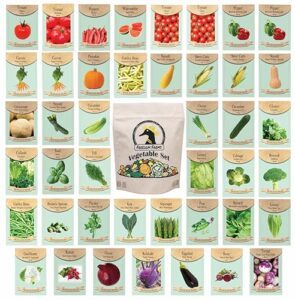
With 43 heirloom seed varieties, the Black Duck Brand set gives you a solid seed selection for pots and small space gardening without breaking the bank. These 100% non-GMO seeds offer variety planting flexibility—from compact tomatoes to herbs—with germination usually happening within 7–14 days.
The included mylar storage bag keeps seeds viable for years in cool, dry conditions, so you can build up your collection gradually.
Though seed quantities are measured by weight rather than count, and germination expectations vary by variety, this assortment helps beginners explore heirloom seed benefits while planning container gardens year-round.
Best For: Budget-conscious gardeners wanting to experiment with diverse heirloom varieties in containers or small garden beds without committing to full-size seed packets.
- 43 different non-GMO heirloom varieties offer excellent diversity for testing what grows best in your specific small-space conditions
- Included mylar storage bag extends seed viability for multiple seasons, letting you pace your planting experiments
- Low per-variety cost makes it easier to try herbs and vegetables you wouldn’t normally purchase individually
- Seeds sold by weight rather than count means you won’t know exactly how many plants you can grow from each variety
- Some customers report receiving duplicate packets or experiencing variable germination rates across different seed types
- Limited quantity per variety may not provide enough seeds for succession planting or backup if initial germination disappoints
5. BlumWay 2 Inch Soil Blocker
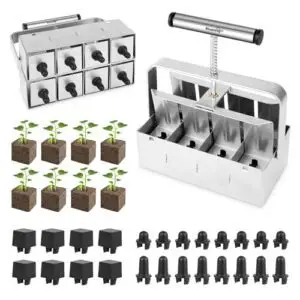
The BlumWay 2 Inch Soil Blocker transforms seed starting containers into a plastic-free operation, creating eight uniform blocks per press—perfect for small space gardening when you’re short on square footage. This stainless steel tool generates soil blocks that fit 78 per standard tray, eliminating up to 100 disposable pots each season while cutting plastic waste by roughly 90%.
Germination rates for lettuce and tomatoes usually hit 78–94%, and seedlings experience less transplant shock than tray-grown plants. You’ll need about 2.5–3 cups of moistened mix per press, and the blocks retain moisture better than smaller sizes, requiring daily watering checks based on your indoor humidity.
Best For: Home gardeners and small-space growers who want to eliminate plastic waste while starting seeds indoors with minimal transplant shock.
- Cuts plastic waste by up to 90% and eliminates the need for roughly 100 disposable pots per growing season
- Reduces transplant shock compared to traditional tray-grown seedlings, helping plants establish faster in the garden
- Durable stainless steel construction lasts for 5,000 uses across multiple growing seasons
- Germination rates for cucumbers (72%) and peppers (80%) trail behind plastic flats by 15–24 percentage points
- Some users report difficulty getting soil to hold together consistently, and block sizes may not match locally available seed starter packs
- Quality control issues include broken plastic dibbers and irregular welding on some units
6. PVP Medium Vermiculite Soil Conditioner
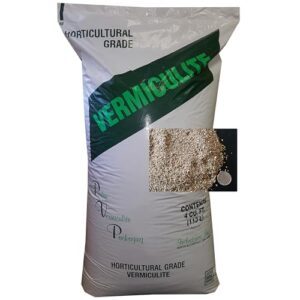
PVP Medium Vermiculite Soil Conditioner acts like tiny sponges in your growing medium, holding moisture and nutrients while keeping air pockets open for healthier roots. This 4-pound bag delivers roughly 103 quarts of pH-neutral material that’s perfect for seed starting mix, hydroponic use, and soil-less germination setups.
You’ll notice faster seed germination and stronger root development because vermiculite improves soil aeration without the soil mess of heavier amendments. It’s sterile and odorless, which virtually eliminates damping-off—a common seedling killer in tight indoor spaces.
The texture runs finer than some gardeners expect, closer to light sand, so moisture retention may vary depending on your mix ratio.
Best For: Gardeners starting seeds indoors, propagating cuttings, or building custom soil-less mixes who want better aeration and moisture control without heavy amendments.
- Speeds up seed germination and root growth while virtually eliminating damping-off disease thanks to its sterile, pH-neutral composition
- Acts as a natural sponge that holds moisture and nutrients while maintaining excellent aeration for healthier root systems
- Works in multiple setups—seed starting, hydroponics, rooting mixes—and helps prevent soil from becoming hydrophobic
- Texture runs finer than expected, more like light sand, which may not suit all gardening purposes
- Moisture retention can be lower than anticipated due to the dusty, fine consistency
- May require mixing with other materials to achieve the desired texture and water-holding capacity for specific plants
7. Burpee 72 Cell Seed Starter
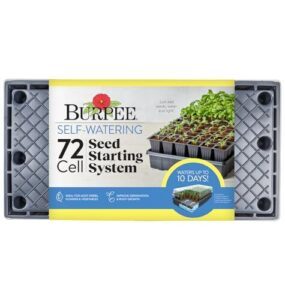
You can start up to 72 seedlings at once in the Burpee 72 Cell Seed Starter, a compact 10-by-20-inch tray that fits perfectly on windowsills or under grow lights. The self-watering system uses a wicking mat and gallon-sized reservoir to keep moisture steady for up to 10 days, which helps prevent the overwatering issues that often kill seedlings in small spaces.
You get plant markers and diagrams to track your varieties, plus a clear dome that shows you exactly when condensation forms. The durable plastic trays hold up season after season, and at around $19 to $20 from major retailers, this kit delivers serious seedling capacity without hogging your limited square footage.
Best For: Home gardeners with limited space who want to start a large number of seedlings indoors without constant watering attention.
- Self-watering system maintains consistent moisture for up to 10 days, reducing daily maintenance and preventing overwatering
- High capacity of 72 cells in a compact 10×20-inch footprint maximizes seedling production in small spaces
- Reusable trays and included organization tools (markers and plant-o-gram diagrams) provide long-term value at around $19-$20
- Removing seedlings from cells can be difficult and may disturb roots during transplanting
- Self-watering system can be messy to handle and refill if not managed carefully
- Some users report mold growth issues and coco coir pellets that don’t expand properly without correct preparation
8. Root Radish Red Organic Bunch
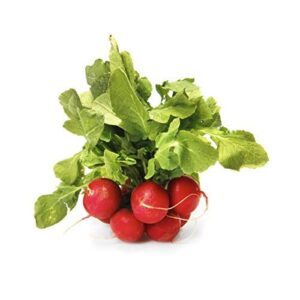
You’ll see Root Radish Red Organic Bunch listed alongside seed starting gear, but this is actually the harvested crop—not seeds. If you’re growing radishes in your small space gardening setup, though, they’re perfect for container gardening and tight spots.
Radishes mature in 3 to 4 weeks, making them ideal for quick harvests in your vegetable garden. You can toss them into salads, blend them in smoothies, or munch them as snacks for solid nutritional benefits.
Keep in mind that organic root vegetables sometimes arrive sandy, and texture can vary from crisp to woody depending on growing conditions.
Best For: Home gardeners looking for quick-growing, organic produce in small spaces or containers.
- Matures in just 3-4 weeks for fast harvests
- Works great in containers and tight growing areas
- Versatile for salads, smoothies, and snacking
- Often arrives sandy or muddy and needs washing
- Texture can be inconsistent—some may be woody
- Costs more than conventional radishes
9. Hydroponic Seed Starter Tray Kit
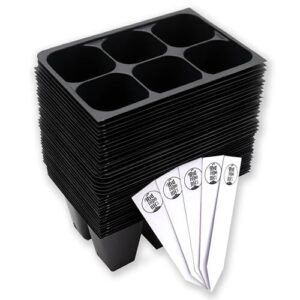
Hydroponic seed starter trays bring soil-free growing to your countertop or corner shelf. You’ll find kits using rockwool or coco coir as growing media, which hold moisture while letting roots breathe—germination rates hit 85–98% under controlled conditions.
These systems work well for leafy greens, herbs, and compact vegetables in tight quarters. Humidity domes keep moisture steady, and some kits include air pumps to prevent root rot.
Prices range from $6 to $63 depending on size and features. If you’re short on square footage but want faster seedling growth, hydroponic setups deliver results without the mess of traditional soil trays.
Best For: Urban gardeners and apartment dwellers who want faster seedling growth without the mess of soil-based trays.
- Achieves germination rates of 85–98%, outperforming traditional soil methods by 10–20%
- Accelerates early root development by up to 25%, shortening overall crop cycles
- Reduces damping off disease by up to 40% when moisture levels are properly maintained
- Requires monitoring of pH levels (5.5–6.5) and nutrient solutions for optimal results
- Higher-end kits with air pumps and advanced features can cost up to $63
- Growing media like rockwool or coco coir needs replacement between growing cycles
10. Scott ComfortPlus Toilet Paper Double Rolls
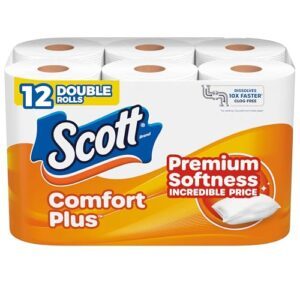
Repurposed household items like toilet paper rolls cut waste while starting seeds. Scott ComfortPlus Double Rolls give you sturdy cardboard tubes after you’ve used the tissue—231 sheets per roll means fewer replacements and more tubes for seedlings.
These recycled containers work perfectly for tomatoes, peppers, and herbs since roots push through biodegradable cardboard when transplanted. The rolls’ tissue strength and septic safety matter for your bathroom, but gardeners love the cores for starting plants without buying plastic pots.
With sustainable sourcing and strong consumer reviews averaging 4.37 stars, you’re supporting eco-friendly practices while repurposing household items that would otherwise hit the trash.
Best For: Budget-conscious households that want reliable, septic-safe toilet paper and can repurpose the sturdy cardboard cores for DIY projects like seed starting.
- Strong and thick for 1-ply (4x stronger, 3x thicker than leading value brands) with fast dissolving for septic safety
- Affordable at about $0.03 per square foot with solid customer ratings (4.37/5 stars)
- FSC-certified sustainable sourcing and 100% recycled cores support eco-friendly practices
- Double rolls are smaller than expected with only 231 sheets per roll, requiring more frequent changes
- 1-ply may feel thin compared to multi-ply options preferred by some users
- Brand linked to boreal forest clear-cutting concerns despite sustainability certifications
Expert Tips for Successful Small-Space Gardening
Getting the most from a small growing space takes more than just the right products. You’ll need to manage a few key factors to keep your seedlings thriving and your containers productive.
Here’s what makes the difference between struggling plants and a garden that truly delivers.
Managing Watering and Light for Healthy Seedlings
Getting the balance right between water and light can feel like walking a tightrope, but your seedlings will reward you with strong, vigorous growth when you nail these two essentials. Check moisture levels daily by testing the soil with your finger. Water when the top feels dry, but don’t drench it.
Your LED lights should run 14-16 hours per day, providing the full light spectrum seedlings crave. Maintain good seedling spacing and humidity control to prevent damping-off disease while monitoring growth for any signs of trouble.
Moving Containers to Follow Sunlight
As the sun traces its path across your balcony or patio throughout the day, your containers can become mobile garden soldiers, chasing those precious rays to get the most out of growth. Track where sunny windows deliver peak light exposure during different seasons, then shift your pots accordingly.
- Morning sun works best for heat-sensitive greens, while afternoon rays benefit tomatoes and peppers with plant-specific needs
- Turn containers weekly to make certain even growth and get the most out of photosynthesis on all sides
- Watch for wilting or scorched leaves as signs you’re either missing the ideal position or risking sun damage
This seasonal sun tracking transforms limited growing area into a flexible system where your small space gardening techniques adapt throughout the day, giving seedlings what they need without investing in expensive sunlight alternatives.
Fertilizing and Maintaining Container Gardens
Container plants burn through nutrients fast since water drains away fertilizer with every watering, so you’ll need to replenish what gets lost if you want strong, productive growth.
Feed your container gardening crops every two weeks with diluted liquid fertilizer, checking drainage holes regularly to prevent waterlogged potting mix.
Consistent watering paired with proper nutrient replenishment keeps your plants thriving, while seasonal adjustments help you dial in care as temperatures shift.
Using Native Plants to Support Pollinators
When you’re seed starting in small spaces, choosing native plants sets you up for eco-friendly gardening success while boosting pollinator visitation rates by up to 37% compared to non-native options. Native plant diversity directly bolsters specialist bee reliance on regional flora, creating habitats that invasive plant impact has diminished. You’ll attract more pollinators to your small-space vegetable gardening setup while enjoying economic benefits through healthier crops and reduced pest control needs.
- Bolster specialist pollinators: Between 15% and 60% of North American native bees depend exclusively on specific native plants for survival and reproduction.
- Elevate pollinator visits: Native plants attract considerably more pollinator species and total visits throughout the growing season compared to exotic varieties.
- Strengthen local ecosystems: Greater native plant variety increases mating, nesting, and foraging opportunities for pollinators in fragmented urban habitats.
- Reduce chemical dependency: Native plants encourage beneficial predators that naturally control harmful insects, with only 1% of insects actually posing threats to your garden.
Accessing Local Gardening Resources and Advice
You don’t have to figure everything out alone when seed starting in small spaces. Extension services maintain over 3,000 county offices nationwide, offering free gardening advice resources through trained volunteers and Master Gardeners who’ve completed 40 to 100 hours of specialized training. Local workshops fill fast—often within 48 hours—so check your area early for hands-on sessions covering everything from soil health to environmental gardening practices.
| Resource Type | What You’ll Find |
|---|---|
| Extension Service & Master Gardener Hotline | Free expert advice, soil testing, pest management support from trained volunteers |
| Local Workshops & Garden Volunteering | Hands-on training, certificate programs, seasonal carpentry classes, community connections |
| Online Networks | Interactive tools, webinars, forums connecting 1.5+ million gardeners seeking localized advice |
Frequently Asked Questions (FAQs)
How do I prevent leggy seedlings indoors?
Leggy seedlings happen when Light Intensity is too low or light duration too short. Place seedlings under LED lights or grow lights for 14-16 hours daily, positioned 2-4 inches above plants.
Improve Air Circulation with a small fan, and avoid Seedling Density by spacing properly.
When should I start seeds before transplanting?
Timing is everything—literally your garden’s make-or-break moment. Count backwards from your region’s frost-free date using seed packet info to determine indoor start time.
Most seedlings need 6-8 weeks before transplanting, though a seed starting chart helps nail transplant timing for your regional climate when starting seeds indoors.
What temperature range is best for germination?
Most seeds germinate best between 65-75°F, though seed type matters. Warm-season crops like tomatoes need 75-85°F for best germination rates, while cool-season varieties prefer cooler temperatures around 60-70°F.
How often should I fertilize young seedlings?
Wait until your seedlings develop their first true leaves before fertilizing. Then, use a diluted liquid fertilizer at half strength every week or two to support healthy growth without over-fertilizing risks.
Can I reuse seed starting containers safely?
You can reuse seed starting containers safely with proper sterilization methods.
Wash recycled containers thoroughly, then disinfect them with a bleach solution to prevent disease transmission and root rot, protecting your seedling health from material degradation and rootbound risks.
Conclusion
You could fill a stadium with all the seeds you can start in a shoebox-sized space if you use the right setup. Seed starting in small spaces isn’t about sacrificing variety or yield—it’s about stacking trays, choosing compact varieties, and letting vertical systems do the heavy lifting.
With biodegradable pots, self-watering trays, and a sunny corner, you can grow dozens of seedlings without claiming extra square footage. Your harvest begins the moment you stop thinking horizontally and start building upward.
- https://dashboard.mailerlite.com/forms/757286/144085305517934064/share
- https://wagonwheelhomestead.com/indoor-seed-starting-setup/
- https://www.techgearlab.com/topics/home/best-seed-starter-kit
- https://nosoilsolutions.com/hydroponic-system-cost/
- https://www.reddit.com/r/vegetablegardening/comments/1aj6mcp/starting_seeds_indoors_for_a_newbie/

